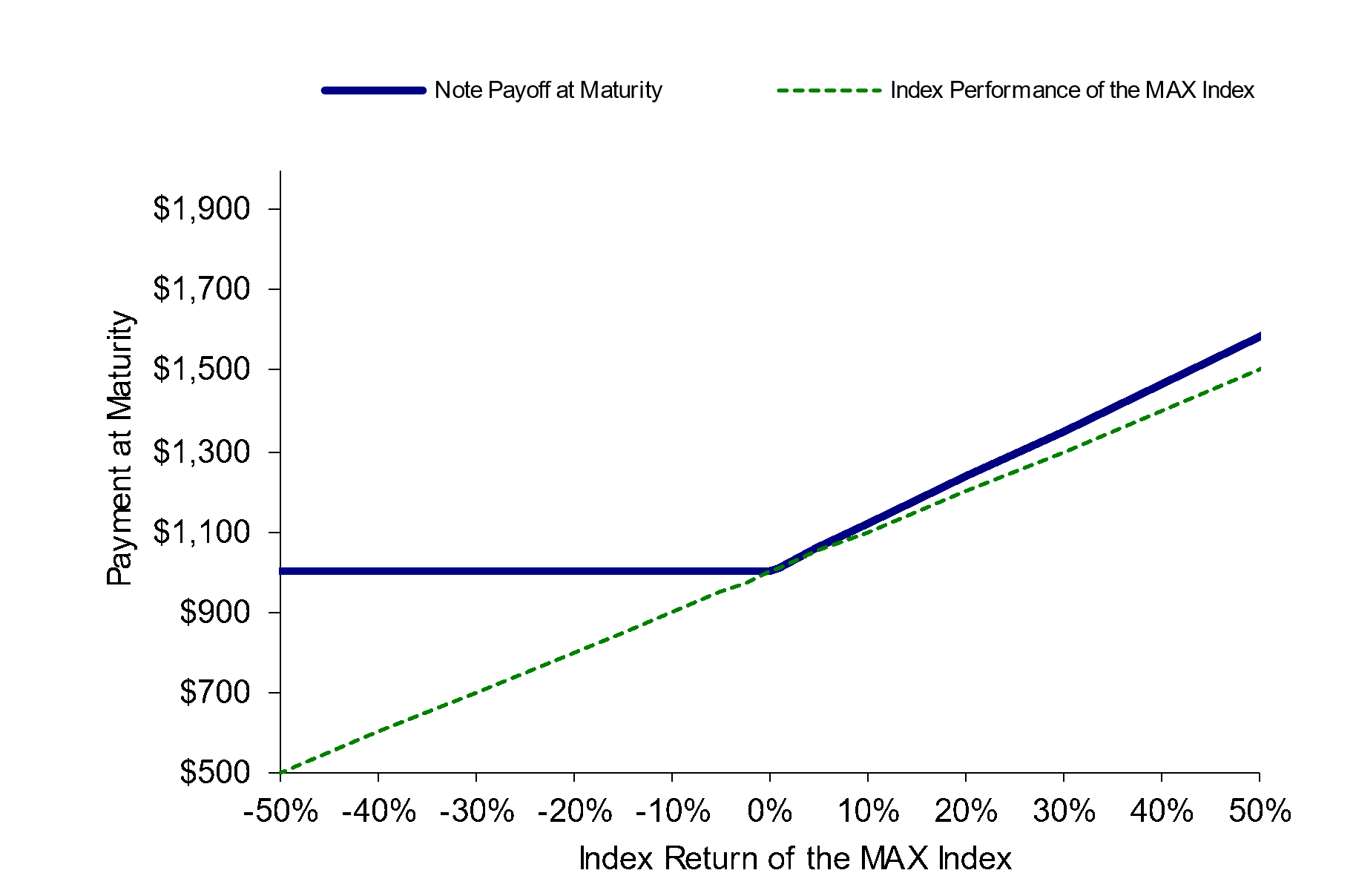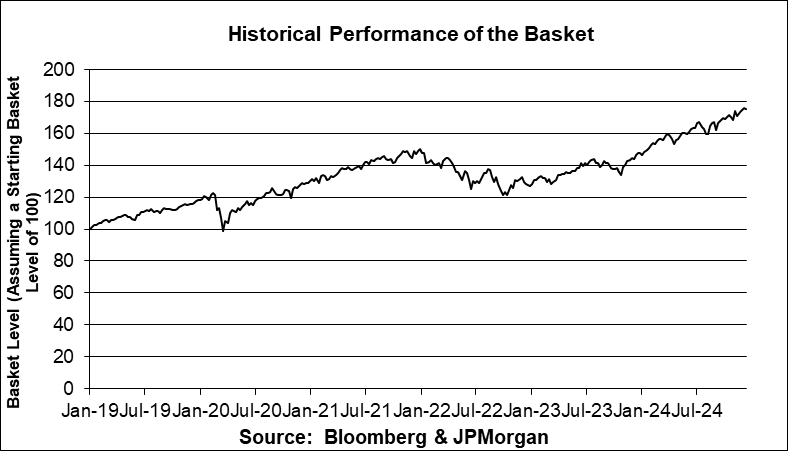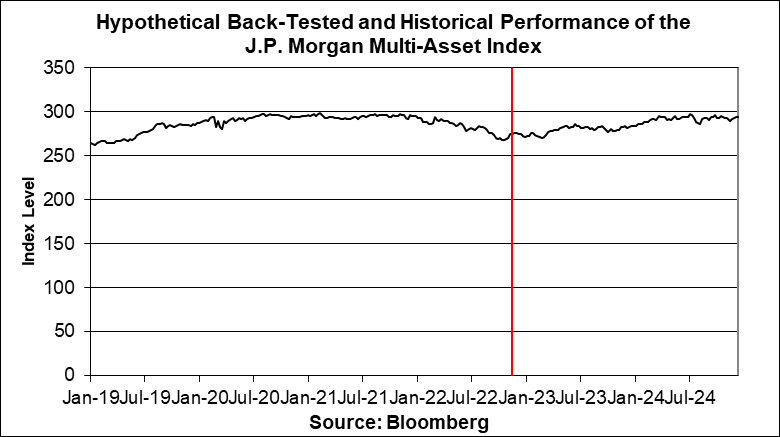Factors — Risks Relating to the Estimated Value and Secondary Market Prices of the Notes — Secondary market prices of the notes will be impacted by many economic and market factors” in the accompanying product supplement.
Risks Relating to the Indices
●JPMORGAN CHASE & CO. IS CURRENTLY ONE OF THE COMPANIES THAT MAKE UP THE S&P 500® INDEX, WHICH IS ALSO THE REFERENCE INDEX UNDERLYING THE FUTURES CONTRACTS INCLUDED IN ONE OF THE EQUITY CONSTITUENTS (AS DEFINED BELOW) OF THE MAX INDEX,
but JPMorgan Chase & Co. will not have any obligation to consider your interests in taking any corporate action that might affect the level of the S&P 500® Index or the securities included in the S&P 500® Index.
●OUR AFFILIATE, JPMS, IS THE INDEX SPONSOR AND INDEX CALCULATION AGENT OF THE MAX INDEX AND MAY ADJUST THE MAX INDEX IN A WAY THAT AFFECTS ITS LEVEL —
JPMS, one of our affiliates, currently acts as the Index Sponsor and the Index Calculation Agent of the MAX Index and is responsible for calculating and maintaining the MAX Index and developing the guidelines and policies governing its composition and calculation. In performing these duties, JPMS may have interests adverse to the interests of the holders of the notes, which may affect your return on the notes, particularly where JPMS, as the Index Sponsor and the Index Calculation Agent of the MAX Index, is entitled to exercise discretion. The rules governing the MAX Index may be amended at any time by its Index Sponsor, in its sole discretion. The rules also permit the use of discretion by the Index Sponsor and the Index Calculation Agent of the MAX Index in relation to the MAX Index in specific instances, including, but not limited to, the determination of whether to replace a Constituent of the MAX Index with a substitute or successor upon the occurrence of certain events affecting that Constituent, the selection of any substitute or successor and the determination of the levels to be used in the event of market disruptions that affect the ability of the Index Calculation Agent of the MAX Index to calculate and publish the levels of the MAX Index and the interpretation of the rules governing the MAX Index. Although JPMS, acting as the Index Sponsor and the Index Calculation Agent of the MAX Index, will make all determinations and take all action in relation to the MAX Index acting in good faith, it should be noted that JPMS may have interests adverse to the interests of the holders of the notes and the policies and judgments for which JPMS is responsible could have an impact, positive or negative, on the level of the MAX Index and the value of your notes.
Although judgments, policies and determinations concerning the MAX Index are made by JPMS, JPMorgan Chase & Co., as the ultimate parent company of JPMS, ultimately controls JPMS. JPMS has no obligation to consider your interests in taking any actions that might affect the value of your notes. Furthermore, the inclusion of any Constituent in the MAX Index is not an investment recommendation by us or JPMS of that Constituent or any of the futures contracts underlying that Constituent.
●AN INVESTMENT IN THE NOTES CARRIES THE RISKS ASSOCIATED WITH THE MAX INDEX’S MOMENTUM INVESTMENT STRATEGY —
The MAX Index construction reflects a momentum investment strategy. Momentum investing generally seeks to capitalize on positive trends in the returns of financial instruments. As such, the weights of the Constituents in the MAX Index are based in part on the recent performance of the Constituents. However, there is no guarantee that recent performance trends will continue in the future. In addition, the caps and floors on the Constituent weights applied at the individual and asset class levels will result in lower weights for the Constituents with the best recent performance than would be the case if those caps and floors were not applied. Moreover, the aggregate assigned weights of the J.P. Morgan US Large Cap Equities Futures Index, the J.P. Morgan US Small Cap Equities Futures Index, the J.P. Morgan German Equities Futures Index and the J.P. Morgan Japanese Equities Futures Index (the “Equity Constituents”) and the aggregate assigned weights of the J.P. Morgan 5Y U.S. Treasury Futures Index, the J.P. Morgan 10Y U.S. Treasury Futures Index, the J.P. Morgan German Government Bond Futures Index and the J.P. Morgan Japanese Government Bond Futures Index (the “Bond Constituents”) in the MAX Index will, in each case, not be less than 10%, even in cases where the recent performance of the Equity Constituents or the Bond Constituents, as applicable, is significantly worse than the recent performance of the remaining Constituents.
Furthermore, the MAX Index will maintain a 100% net long exposure to its Constituents at all times, even when most or all Constituents are displaying negative performance. Moreover, once a selected portfolio has been identified and implemented, the MAX Index will track the performance of the relevant Constituents until the next rebalancing of the MAX Index, even when the performance of those Constituents is worse than their recent performance, or than the performance of the remaining Constituents.
In addition, due to the MAX Index’s momentum investment strategy, the MAX Index may fail to realize gains that could occur as a result of obtaining exposures to financial instruments that have experienced returns one direction, but which subsequently experience a sudden return in the other direction. As a result, if market conditions do not represent a continuation of prior observed trends, the level of the MAX Index, which is rebalanced based on prior trends, may decline.






